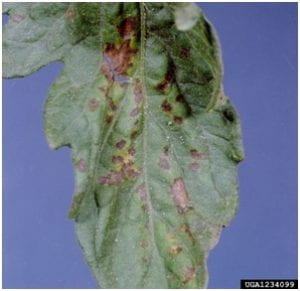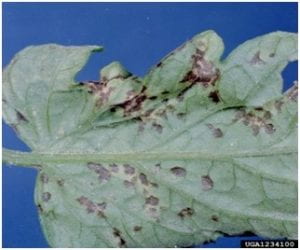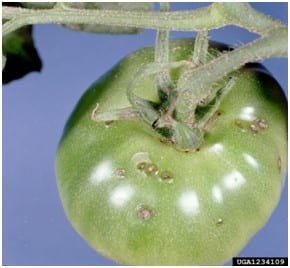Kate Everts, Vegetable Pathologist, University of Delaware and University of Maryland; keverts@umd.edu
Several cases of tomato bacterial spot, which is caused by Xanthomonas campestris pv. vesicatoria have occurred in our region this year. Bacterial spot is favored by warm weather 75-86 F, and by high precipitation. As the name suggests, the symptoms of bacterial spot are dark brown small (less than 1/8th inch in diameter) circular spots that occur on leaves, stems or fruit. The lesions often have a yellow halo and extensive infection on the leaf will result in a blighted appearance. The disease is spread in the field by windblown rain.
The pathogen can be introduced to the field by infected seed, transplants, crop production materials such as stakes or string, and on farm equipment. A rotation of two years is important to reduce inoculum. Once the tomatoes are planted to the field, Actinovate, copper plus mancozeb, ManKocide, and Cuprofix MZ should be sprayed on a 7-day schedule. Copper resistant strains of X. campestris pv. vesicatoria are reported on the Eastern Shore of Virginia and in other parts of the mid-Atlantic region. Therefore growers there are advised to apply Actigard alone or in combination with copper containing products. Organic growers should use organic approved bacterial fungicides.


 Bacterial spot (Xanthomonas vesicatoria) on tomato; symptoms include small brown spots on the leaves, sometimes surrounded by yellow halos. Fruit lesions are small sunken and brown or tan.
Bacterial spot (Xanthomonas vesicatoria) on tomato; symptoms include small brown spots on the leaves, sometimes surrounded by yellow halos. Fruit lesions are small sunken and brown or tan.
Images courtesy of Clemson University – USDA Cooperative Extension Slide Series, Bugwood.org
